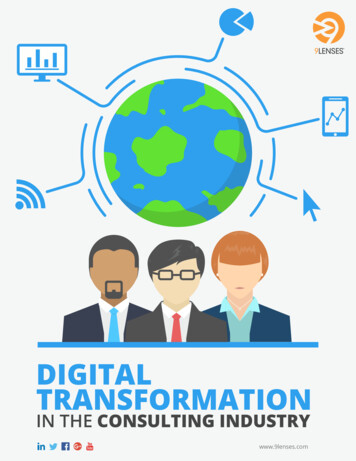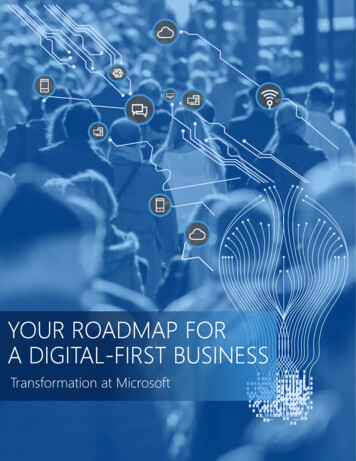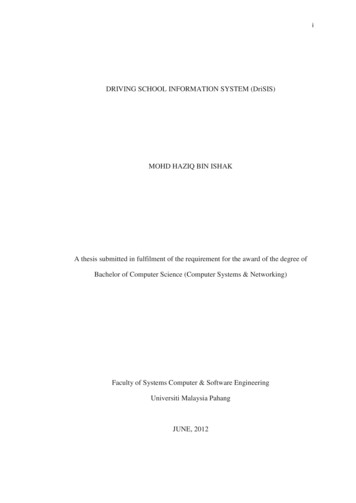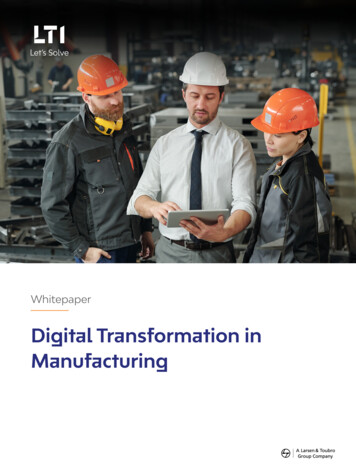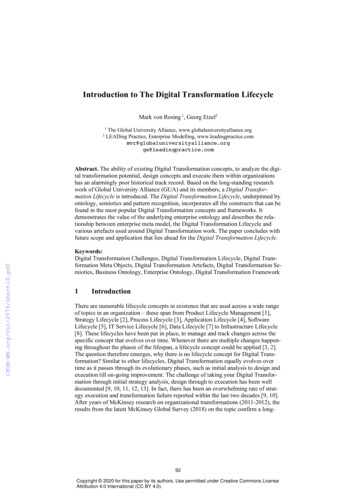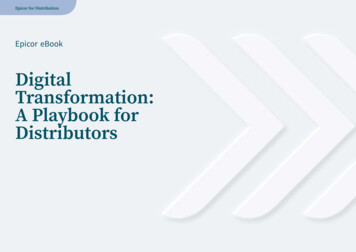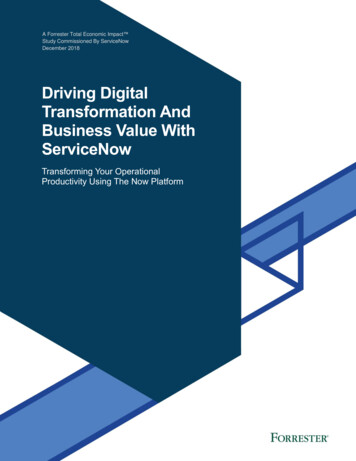
Transcription
A Forrester Total Economic Impact Study Commissioned By ServiceNowDecember 2018Driving DigitalTransformation AndBusiness Value WithServiceNowTransforming Your OperationalProductivity Using The Now Platform
Table Of ContentsExecutive SummaryKey Findings11TEI Framework And Methodology4Digital Transformation With ServiceNowBefore And After The Investment In ServiceNow55Interviewed Organizations5Key Business Challenges And Objectives5Solution Requirements6Key Results6Composite Organization7Analysis Of BenefitsBring New Enterprise Apps To Market In Half The TimeIT Staff Repurposed For Higher-Value Work8810Better Developer Retention From Improved Employee Experience 11Process Efficiencies From Citizen DevelopmentServiceNow: OverviewAppendix A: Total Economic ImpactAppendix B: EndnotesProject Director:Adam Schlegel13151718ABOUT FORRESTER CONSULTINGForrester Consulting provides independent and objective research-basedconsulting to help leaders succeed in their organizations. Ranging in scope from ashort strategy session to custom projects, Forrester’s Consulting services connectyou directly with research analysts who apply expert insight to your specificbusiness challenges. For more information, visit forrester.com/consulting. 2018, Forrester Research, Inc. All rights reserved. Unauthorized reproductionis strictly prohibited. Information is based on best available resources.Opinions reflect judgment at the time and are subject to change. Forrester ,Technographics , Forrester Wave, RoleView, TechRadar, and Total EconomicImpact are trademarks of Forrester Research, Inc. All other trademarks are theproperty of their respective companies. For additional information, go toforrester.com.
Executive SummaryKey Benefits AndValue DriversGet new enterpriseapps to market in½ the timeDigital transformation has become the main catalyst and business goal fororganizational processes initiatives. Increasingly empowered customersand threats from disruptive competitors are heightening this trend.According to Forrester’s Q1 2018 Digital Process Automation Survey, 32%of business and technology decision makers say that accelerating digitalbusiness transformation is their top driver for their process improvementinitiatives.1The cloud-based ServiceNow Now Platform helps customers automate,predict, digitize, and optimize business processes to fuel digitaltransformation. ServiceNow commissioned Forrester Consulting toconduct a Total Economic Impact (TEI) study and examine the potentialbusiness benefits enterprises may realize by deploying ServiceNow tocatalyze digital business transformation.Forrester developed a composite organization representative of fourcustomer interviews and aggregated data from six previous studies andinterviews with 20 additional executives and practitioners to highlight thebenefits realized from catalyzing and expediting their digital businesstransformation using ServiceNow. By using ServiceNow for digitaltransformation, interviewees achieved the following outcomes that havebeen applied to the composite organization:2.5xFaster applicationupdates› Got new enterprise apps to market in half the time. ServiceNowhelped the composite organization bring a new service to market in halfthe time and at one-third the cost of alternative solutions, generatingnearly 1.6 million in high-margin annual revenues per customer.› Achieved 2.5x faster application updates. The organizationaccelerated innovation velocity by fast-tracking the new feature, productrelease, and continuous delivery process using ServiceNow for 35% ofits top developers.› Repurposed 15% of IT service staff to higher-value work. Thecomposite organization repurposed and upskilled over 6 FTEs to highervalue work, equating to approximately 15% of its service desk andaccess management staff.Repurpose 15% ofIT service staff tohigher-value work› Doubled developer satisfaction scores, helping to retain talent. Bymaking developers’ jobs easier and improving their employeeexperience, the composite organization improved retention drivingsavings of 1.36 million per year.› Achieved faster and more cost-effective delivery of businesssolutions via citizen developers. Using low-code development, thecomposite organization built business applications using citizendevelopers closer to the business processes it was transforming,reducing the time to deliver new business applications by as much as80%.Key FindingsTransform your operational productivity. Customers leveraged the NowPlatform to build innovative solutions for complex business challenges, totransform business processes through automation, and to managedemand and resources better.The following risk-adjusted present value (PV) quantified benefits arerepresentative of those experienced by the interviewed companies:1 Driving Digital Transformation And Business Value With ServiceNow
Incremental Benefits OfServiceNow*Three-YearBenefits PV 17.26 millionAverage AnnualBenefit (PV) 5.75 million*In addition to the benefits found in the study,“The Total Economic Impact OfServiceNow For IT, HR, Customer Service,And Security Operations”“With the ability to build out customapplications, reports, andworkflows out of the box,ServiceNow is the solution weuse to create, manage, anddeliver the full life cycle of ourmanaged services.”Ralph Velasco, director, ITtransformation, EY“Now our employees can focus onthe things that matter. I think for along time those teams haven’thad the time to investigate thosenew technologies or do some ofthat work because they’ve beenburied in work and reacting toacute IT issues.”Manager, solution engineering,transportation and logistics› Brought new enterprise apps to market in half the time. Thecomposite organization leveraged the ServiceNow Customer ServiceManagement (CSM) solution to support the organization’s shift to avariable-pricing business model by rapidly building a cloud solution toautomate high volumes of complex compliance workflows in 50% thetime and at 33% the cost of the next-best alternative. Using ServiceNow,the organization demonstrated near-immediate customer value, enablingit to win a competitive tender. Lastly, the organization fully automated95% of these compliance transactions, bolstering profitability andensuring service scalability.› Repurposed 15% of IT service staff to higher-value work. Byautomating manual, unstructured, and error-prone application accessmanagement, provisioning, and service desk tasks, the organizationupskilled and repurposed 6 full-time equivalent (FTE) employees, orapproximately 15% of its service desk and access management staff, tohigher-value work, growing the business and improving profitability.Elevate your employee experience. Building on the Now Platform,customers can enable employees with self-service and rapidly deliver newbusiness applications and services to the employees, customers, andpartners, growing their businesses and boosting operational efficiency andeffectiveness.The following risk-adjusted present value (PV) quantified benefits arerepresentative of those experienced by the interviewed companies:› Doubled developer satisfaction scores, helping to retain talent. Thecomposite organization’s developer experience scores skyrocketed from1.5 out of 5 to 3.5 out of 5 through a number of business and technologyinnovations that made developers’ jobs easier, including self-servicetools, improved incident management, automated testing, andstreamlined feature release processes.› Achieved faster and more cost-effective delivery of businesssolutions via citizen developers. Using low-code development on theNow Platform, the organization could deliver applications and digitalsolutions to the business units faster, using citizen developers closer tothe business processes it was transforming. For more complexapplications, a multidisciplined team consisting of a developer and abusiness analyst could reduce the time to deliver new businessapplications by as much as 80%.Process efficiencies fromcitizen development 793,055Better developerretention 4,079,059 17.3 millionthree-year totalbenefits PV 5.75 millionaverage annualEmployeesreallocated toinnovation 3,205,1902 Driving Digital Transformation And Business Value With ServiceNowNew profit growthfor innovation 9,178,792
Additional benefits. Our interviews revealed several additional benefits that could not be financially quantified aspart of this analysis, as interviewees didn’t have quantifying metrics at the time of the interviews. The compositeorganization realized the following additional benefits that were not quantified as part of the benefit calculation inthe study:› Achieved 2.5 times faster application updates. The organization accelerated innovation velocity by fasttracking the new feature and product release and continuous delivery process using ServiceNow for 35% of itstop developers. This grouping of elite developers could push out an average of 25 product updates, changes,and feature releases to market each month versus just 10 per month for developers outside of the fast-laneprogram. While this inevitably makes organizations more competitive and bolsters the customer experience,interviewees could to provide specific quantifying metrics at the time of the interviews, such as downloads,monthly active users, conversion rates, or app store reviews.› Accelerated cloud transformation. One interviewee leveraged ServiceNow to accelerate its move of 15% ofits server fleet to the cloud, saving the organization 3 million annually. Since the exact increase in speed tothe cloud could not be determined at the time of the interview, this benefit was not included in the calculationsfor this study.Forrester’s interviews and subsequent financial analysis found that an organization based on these customersexperienced risk- and present value-adjusted benefits of 17.26 million over three years, or 5.75 million inaverage annual business benefits. These digital transformation business benefits are incremental to the 82.5million in benefits discussed in the Forrester case study, “The Total Economic Impact Of ServiceNow For IT,HR, Customer Service, And Security Operations”, which demonstrates a 256% return on investment (ROI), netpresent value (NPV) of 59.3 million, and a 10-month payback period for organizations that invest in ServiceNowfor IT, HR, customer service, and security operations. Readers should use these studies in conjunction tounderstand the full business impact of digital transformation using ServiceNow on their own organizations.Defining Digital TransformationTransform youroperational productivity20% IT productivityincreaseRepurpose 15% ITservice staff tohigher-value work25% fewer majoroutagesGet new enterpriseapps to market inhalf the timeElevate youremployee experience2x developersatisfaction scores30% faster HRcase resolutionReimagine yourcustomer engagement10-point supportcall NPS* increasescores10% faster issueresolution50% employeeinquiries resolvedinstantly45% faster securityincident response*Net Promoter and NPS are registered service marks, and Net Promoter Score is a service mark, of Bain & Company, Inc., SatmetrixSystems, Inc., and Fred Reichheld.3 Driving Digital Transformation And Business Value With ServiceNow
TEI Framework And MethodologyFrom the information provided in the interviews, Forrester has constructed aTotal Economic Impact (TEI) framework for those organizationsconsidering implementing ServiceNow for their digital transformation.The objective of the framework is to identify the cost, benefit, flexibility, andrisk factors that affect the investment decision. Forrester took a multistepapproach to evaluate the impact that ServiceNow can have on anorganization. These findings have been amalgamated with the analysesfrom existing Forrester case studies on ServiceNow solutions and presentedin a broader overview.The TEI methodologyhelps companiesdemonstrate, justify,and realize thetangible value of ITinitiatives to bothsenior managementand other keybusinessstakeholders.DUE DILIGENCEInterviewed ServiceNow stakeholders and Forrester analysts to gather datarelative to ServiceNow.CUSTOMER INTERVIEWSInterviewed four organizations using ServiceNow products as part of theirdigital transformation, to obtain data with respect to costs, benefits, andrisks. Data from 20 previously interviewed ServiceNow customers was alsoutilized for our analysis.COMPOSITE ORGANIZATIONDesigned a composite organization based on characteristics of theinterviewed organizations.FINANCIAL MODEL FRAMEWORKConstructed a financial model representative of the interviews using theTEI methodology and risk-adjusted the financial model based on issuesand concerns of the interviewed organizations.CASE STUDYEmployed the fundamental elements of TEI in modeling the impact ofServiceNow: benefits, costs, flexibility, and risks. Given the increasingsophistication that enterprises have regarding business case analysesrelated to IT investments, Forrester’s TEI methodology serves to provide acomplete picture of the total economic impact of purchase decisions.Please see Appendix A for additional information on the TEI methodology.DISCLOSURESReaders should be aware of the following:This study is commissioned by ServiceNow and delivered by ForresterConsulting. It is not meant to be used as a competitive analysis.Forrester makes no assumptions as to the potential business benefits that otherorganizations will receive. Forrester strongly advises that readers use their ownestimates within the framework provided in the report to determine theappropriateness of an investment in ServiceNow.ServiceNow reviewed and provided feedback to Forrester, but Forrestermaintains editorial control over the study and its findings and does not acceptchanges to the study that contradict Forrester’s findings or obscure themeaning of the study.ServiceNow provided the customer names for the interviews but did notparticipate in the interviews.4 Driving Digital Transformation And Business Value With ServiceNow
Digital Transformation With ServiceNowBefore And After The Investment In ServiceNowInterviewed OrganizationsFor this study, Forrester conducted four interviews with customers with transformative use cases forServiceNow. Interviewed customers had the following W DEPLOYMENTCHARACTERISTICSProfessional servicesEMEASenior manager, ITtransformationCustomer Service Management, NowPlatformProfessional servicesEMEAManaging director,experienceITSM, HR Service Delivery, NowPlatformTransportation andlogisticsNorth AmericaManager, solutionengineeringITSM, Performance Analytics, ITOM,HR Service Delivery, Now PlatformFinancial servicesNorth AmericaDirector, global platformand infrastructureITSM, Asset Management, ITBM,Performance Analytics, Now PlatformKey Business Challenges And ObjectivesInterviewees shared several key business challenges and objectivesthat collectively persuaded leadership to explore a modern platform tocatalyze their digital business transformation efforts.› Flexibility to rapidly transform business models to be morecompetitive and meet emerging customer business needs.Customers challenged professional service interviewees to becomemore embedded in the success of the business processes they werebeing asked to optimize. As such, the professional serviceinterviewees needed a solution that could help them evolve theirbusiness and pricing models away from one-off projects to ongoingmanaged services.› Challenges acquiring and retaining talent in a hypercompetitiveenvironment. The ability to acquire, retain, and grow key talent istop of mind for C-level executives across virtually every industry. Thisis for good reason: Replacement costs for highly trained positionscan be as high as 213% of an employee’s annual salary, and anorganization can lose up to 20% of new talent in the first 45 days ofemployment.2“Our client needed a providerwho could charge pertransaction, which is adeparture from our fixed-feemodel. We needed a flexibleplatform that could fosterautomation, that we couldstand up as quickly aspossible and get it to work.”Ralph Velasco, director, ITtransformation, EY› High costs, process inefficiencies, and poor governance causedby the proliferation of competing point solutions. Business unitshad a hodgepodge of disparate, unconnected systems, oftencompeting against each other for the same business processes andobjectives. This proliferation of redundant systems resulted in highcosts and made it impossible to work cross-functionally across thebusiness with a shared language and set of processes.“I think the value [of ServiceNow] for our business is to increase innovation velocity and make decisions faster.I think this platform has allowed us to be even more competitive in the marketplace.”Director, global platform and infrastructure, financial services5 Driving Digital Transformation And Business Value With ServiceNow
› Lack of tools to disrupt the business. From a strategic standpoint,interviewees indicated that their legacy technologies were inhibitorsof digital transformation. One interviewee said: “We didn’t have thetools to disrupt to the business. We can’t disrupt the business withtools that are hard to upgrade, that don’t have an architecture thatallows flexibility, that take a really long time to implement and don’tshow well.” As such, a modern, flexible platform that would grow withtheir businesses was key to supporting successful transformationinitiatives.› Workflow inefficiencies and business continuity risks causedby inconsistent, error-prone manual processes. Commonbusiness processes across business units varied drastically, whilehighly manual workflows resulted in errors and rework. Seniormanagement lacked visibility across business-critical workflows,which often hid the insidious costs of these disparate systems —both in terms of operational costs and user inefficiencies. All of thiscreated significant business continuity risks, as the workflows andgovernance that underlie these unstructured business processescould be completely disrupted by key employees leaving thebusiness, throwing entire business units into disarray.“We had a lot of proliferation ofone-off solutions. . . . We hada lot of department-specificapplications. We even hadredundant, overlappingsolutions competing againsteach other in the company.This was very costly.”Managing director, experience,professional servicesSolution RequirementsThe interviewed organizations searched for a solution with thesecharacteristics:› Architecture and scalability to disrupt the entire business.Interviewees looked for solutions that could be equally disruptiveacross IT, finance, marketing, legal, media, facilities, and other areasof the business. One interviewee leveraged ServiceNow in 120business groups outside of IT. A solution that didn’t have wideranging capabilities was a nonstarter.› Automated, cost-effective, and easy to implement. Intervieweeslooked for a cloud-based solution that could be quickly implementedand scaled beyond IT.› Ability to facilitate business model transformation. At the time ofthe interviews, the traditional business models of severalServiceNow customers were being disrupted, forcing them to adoptnew business models, create new value-added services, and adaptto the reality that becoming a software company would be critical formaintaining competitive advantage going forward.Key ResultsOur interviews with customers using ServiceNow solutions andcapabilities to fuel their digital business transformation efforts revealedthe following key results and outcomes:› Increased focus on digital transformation. As the impact ofServiceNow quickly spread beyond IT to the lines of business, eventhe most sacrosanct legacy technologies and business processeswere challenged and disrupted. With the Now Platform, citizendevelopers helped business units rapidly digitize and replace theirmanual, inefficient, and costly legacy technologies and processes,and employees were repurposed to projects that improved theexperiences of employees and customers.6 Driving Digital Transformation And Business Value With ServiceNow“To adopt a variable pricingmodel, where we would begetting paid based ontransactions, we needed aflexible, efficient platform toautomate these processes andmaximize profit from each ofthose transactions.”Ralph Velasco, director, ITtransformation, EY
› Rapid delivery of new offerings and business services.Interviewees leveraged multiple ServiceNow solutions to rapidlybuild and deploy new revenue-generating customer offerings andemployee-facing business services. One organization usedServiceNow as the backbone of its growing managed servicesportfolio, supporting millions of dollars in high-margin revenuestreams for the business. Productivity-enhancing business servicesdelivered through ServiceNow streamlined business workflows andfreed up human capital to focus on disrupting and transforming thebusiness.› Faster time-to-market and reduced development and operatingcosts. Interviewees leveraged the ServiceNow cloud-based CSMsolution to rapidly prototype and develop new offerings and businessservices, bringing new services to market in a fraction of the timeand cost of custom or alternative solutions. Rather than spendingweeks standing up infrastructure and months building greenfieldapplications, organizations configured automated businessworkflows, analytics, and reports out of the box, demonstrating nearimmediate value to customers and internal stakeholders alike.“From a strategic perspective,we were looking beyond ITSMto find a platform that wasflexible, that could grow withus as a business.”Managing director, experience,professional services› Faster innovation. One organization created a fast-track processfor its top developers using ServiceNow, enabling them to push 2.5times as many application updates and feature releases to marketthan they did before. The interviewee indicated that this processprotected its competitive advantage and differentiation in themarketplace.› Transformation of the employee experience. Several intervieweesused ServiceNow to transform the experiences of their employees,while positioning their brands as digital leaders to attract highlyprized millennial talent. One organization rolled out a number ofstreamlined developer workflows and technologies in parallel withHR improvements that enhanced the employee experience, doublingthe average employee satisfaction score reported by its employees.These improvements save organizations considerable time andmoney from better retention of employees.“Employee experience becamea concept that was lit on fireby ServiceNow in our systemof experience strategy.”Managing director, experience,professional servicesComposite OrganizationBased on interviews with four ServiceNow customers and dataaggregated from six ServiceNow Total Economic Impact studies,Forrester constructed a composite organization to highlight thefinancial benefits from implementing multiple ServiceNow solutions aspart of a broader digital transformation. The organization:› Is based in the U.S. with 17,500 FTEs and 4,000 developers(including contractors).› Has 4 billion in annual revenue.› Employs 500 IT FTEs, including 40 service desk and applicationaccess management employees.› Has multiple ServiceNow solutions employed, including ITSM, ITOM,Performance Analytics, Customer Service Management, ITBM, andthe Now Platform.7 Driving Digital Transformation And Business Value With ServiceNowServiceNow SolutionsITSMITOMPerformance AnalyticsCustomer ServiceManagementITBMNow Platform
Analysis Of BenefitsQUANTIFIED BENEFIT DATA AS APPLIED TO THE COMPOSITETotal BenefitsREF.BENEFITYEAR 1YEAR 2YEAR 3TOTALPRESENTVALUEAtrBring new enterprise apps tomarket in half the time 439,020 3,608,573 7,716,328 11,763,921 9,178,792BtrIT staff repurposed for highervalue work 923,400 1,323,540 1,692,900 3,939,840 3,205,190CtrBetter developer retentionfrom improved employeeexperience 1,640,250 1,640,250 1,640,250 4,920,750 4,079,059DtrProcess efficiencies fromcitizen development 292,015 313,719 357,127 962,861 793,055Total benefits (risk-adjusted) 3,294,685 6,886,082 11,406,605 21,587,372 17,256,096Bring New Enterprise Apps To Market In Half TheTimeSeveral interviewees identified the ability to rapidly build newapplications, products, and business services to meet new customerand market challenges as a key element of the Now Platform’s value.At the time of the interviews, the traditional business models of severalServiceNow customers were being disrupted, forcing them to adoptnew business models and create new value-added services.The table above shows the total of allbenefits across the areas listed below,as well as present values (PVs)discounted at 10%. Over three years,the composite organization expectsrisk-adjusted total benefits to be a PVof nearly 17.3 million.ServiceNow played a critical role in enabling a professional serviceprovider to meet the increasingly complex compliance challenges of itscustomers. The massive and growing volume of its customer’s networkdata that needed to be monitored for compliance violations required ahighly automated solution that could be administered on a price-pertransaction, or per-violation-notification, basis. Given the organization’sone-off, project-based business model, along with the highlycompetitive request-for-proposal (RFP) process it was subject to, theorganization needed a solution that could be rapidly stood up out of thebox and could automate front- and back-end service delivery to deliverthis service profitably.To meet the compliance workflow automation requirements of oneclient, this organization explored several customer service workflowmanagement and custom .NET application options to build out a new,transaction-based business service and model. The organization didan internal, 30-day proof of concept with several customer servicesolutions and selected ServiceNow due to the cost effectiveness of itscloud-based model and its analytics capabilities to monitor and pricebased on transaction volumes.8 Driving Digital Transformation And Business Value With ServiceNowGet new enterprise appsto market in½ the time
The professional service provider noted that the use of ServiceNowhelped it demonstrate value to the client within two weeks, enabling itto win a highly competitive RFP. Furthermore, the organization wasable to begin billing for its new service within just six months,approximately half the time it would have taken to implement, train,and set up IT operations using alternative customer service workflowsolutions. Lastly, the organization indicated that the operational costsfor implementing the new, ServiceNow-based managed complianceservice offering was one-third the cost of alternative solutions.In modeling the impact of ServiceNow in driving new solution revenueand profit growth for the composite organization, Forrester assumesfrom our research:66%Reduction in new serviceresearch anddevelopment costs› The number of customers the organization serves with itscompliance service grew from a single client in Year 1 to five clientsin Year 3.› The organization processes between 7,500 and 12,500 compliancetransaction per day over the three-year analysis (row A2 in tablebelow). The organization charges each customer 50 cents pertransaction.› The organization grows the percentage of fully automatedcompliance transactions from 92% of all transactions in Year 1 to95% of all transactions in Year 3.› Automated transactions bring a conservatively estimated 80% grossmargins, while nonautomated transactions bring a loss of 8 cents(rounded) per transaction, equating to a gross margin of -16%.› The organization delivers an average annual gross run-rate of nearly 1.6 million per customer, yielding overall offering gross marginsgrowing from 72% in Year 1 to 75% in Year 3 due to better processautomation.New product and service revenues and gross margins will vary widelybased on solution area, pricing model, and the degree of automationembedded in service delivery. To account for these risks, Forresteradjusted this benefit downward by 10%, yielding a three-yearrisk-adjusted total PV of nearly 9.2 million.9 Driving Digital Transformation And Business Value With ServiceNowGross margin by yearYear 1: 72%Year 2: 73%Year 3: 75%Impact risk is the risk that the businessor technology needs of theorganization may not be met by theinvestment, resulting in lower overalltotal benefits. The greater theuncertainty, the wider the potentialrange of outcomes for benefitestimates.
Bring New Enterprise Apps To Market In Half The Time: Calculation TableREF.METRICA1Number of customersA2Average number of transactions per client,per dayA3Number of revenue-generating days per yearA4Price per transactionA5Automated transactionsA6Nonautomated transactionsA7YEAR 1YEAR 2YEAR 3135Growing YoY7,50010,00012,5006 mos.implementation inY1180365365 0.50 0.50 0.50A1*A2*A3*% 1,875A1*A2*A3*% nonautomated‡108,000766,5001,140,625Gross margin automated80%80%80%A8Gross margin nonautomated-16%-16%-16%AtBring new enterprise apps to market in halfthe time(A5*A4*A7) ((A6*(A4-(35/60) cents)) 487,800 4,009,525 8,573,698Risk adjustment 10% 439,020 3,608,573 7,716,328AtrCALC.Bring new enterprise apps to market in halftime (risk-adjusted)†The percentage of transactions automated ranges from 92% in Year 1 to 95% in Year 3‡The percentage of nonautomated transactions ranges from 8% in Year 1 to 5% in Year 3IT Staff Repurposed For Higher-Value WorkPrior to adopting ServiceNow, all interviewees expressed frustrationwith the inefficiencies, high costs, and governance challenges of usingdisparate, legacy technologies and business processes. Thesebusinesses indicated that resources were overutilized and additionalhires were needed to handle
approach to evaluate the impact that ServiceNow can have on an organization. These findings have been amalgamated with the analyses from existing Forrester case studies on ServiceNow solutions and presented in a broader overview. DUE DILIGENCE Interviewed ServiceNow stakeholders and Forrester analysts to gather data relative to ServiceNow.



